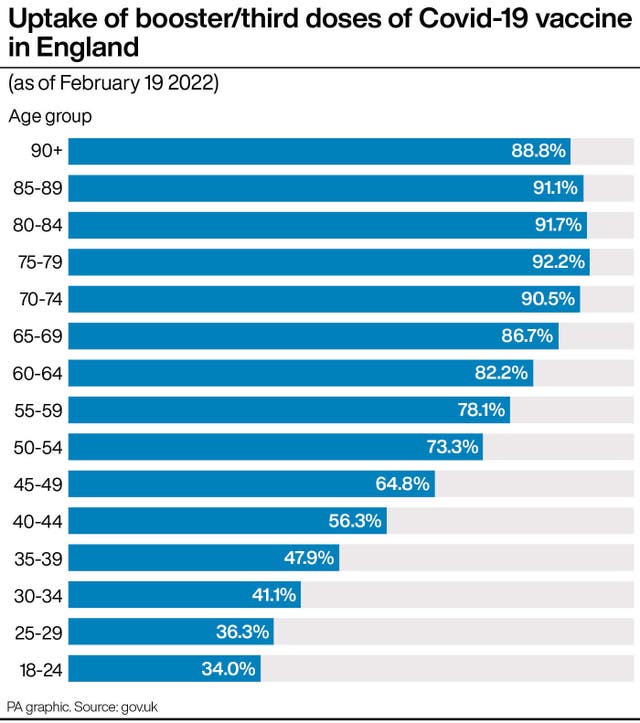Extra Covid boost in spring for over-75s and people at high risk
In interim guidance, the JCVI said that a further dose for older people and those at risk is likely to be needed this autumn.

People aged 75 and over, the immunosuppressed and those living in care homes will be offered a Covid-19 booster vaccine this spring, the Health Secretary has announced.
Sajid Javid said the top-up jab will help those at the highest risk of serious illness maintain a high level of protection against the virus.
The NHS in England will offer people the jab from around six months after their last dose, with further details due to be set out shortly.
Wales, Scotland and Northern Ireland are expected to make similar announcements after the Joint Committee on Vaccination and Immunisation (JCVI) published UK-wide advice recommending the boosters.

In interim guidance published for planning purposes, the JCVI said a further dose for older people and those at risk is likely to be needed this autumn.
This is because, although vaccines offer strong protection, their effectiveness does wane over time and Covid surges are expected in winter.
The autumn jab campaign is expected to cover a wider group of people than in the spring and could include any new Covid vaccines that are available.
It has not yet been decided whether all those currently eligible for an annual flu vaccination will be included.
Mr Javid said: “Thanks to our Covid-19 vaccination rollout, we are already the freest country in Europe.
“It has saved countless lives, reduced pressure on the NHS and is allowing us to learn to live with the virus.

“Today I have accepted the advice from the independent Joint Committee on Vaccination and Immunisation (JCVI) to offer, from spring, an additional Covid-19 booster jab to people aged 75 years and over, residents in care homes for older adults, and people aged 12 years and over who are immunosuppressed.
“All four parts of the UK intend to follow the JCVI’s advice.
“We know immunity to Covid-19 begins to wane over time.
“That’s why we’re offering a spring booster to those people at higher risk of serious Covid-19 to make sure they maintain a high level of protection. It’s important that everyone gets their top-up jabs as soon as they’re eligible.
“The JCVI will keep under review whether the booster programme should be extended to further at-risk groups.”
According to the UK Health Security Agency (UKHSA), most of the UK’s oldest adults received their last vaccine in September or October last year.
The vaccines used in the spring programme will be the 50mcg Moderna vaccine or 30mcg Pfizer/BioNTech vaccine for adults aged 18 and over.
For anyone eligible aged 12 to 18, a 30 mcg Pfizer/BioNTech dose is being offered.
The JCVI said the new recommendation was “precautionary” and people did not face immediate danger to their health, but those being offered a booster had weaker immune systems and may see vaccine effectiveness wane more quickly.
Data suggests that older people who have had two doses of a Covid vaccine have about 45% protection against hospital admission with Omicron, rising to 90% straight after their first booster.
Ten weeks later, that protection has dropped to about 88% but the JCVI believes that even a small drop off in protection among vulnerable and older people can have a large impact, including on hospital admissions and the NHS.
Around 7.2 million people in the UK aged over 75 will be eligible for the top-up dose, as will around half a million people who are immunosuppressed.
Professor Wei Shen Lim, chairman of Covid-19 vaccination on the JCVI, said: “Last year’s booster vaccination programme has so far provided excellent protection against severe Covid-19.
“To maintain high levels of protection for the most vulnerable individuals in the population, an extra spring dose of vaccine is advised ahead of an expected autumn booster programme later this year.
“The JCVI will continue its rolling review of the vaccination programme and the epidemiological situation, particularly in relation to the timing and value of doses for less vulnerable older adults and those in clinical risk groups ahead of autumn 2022.”





